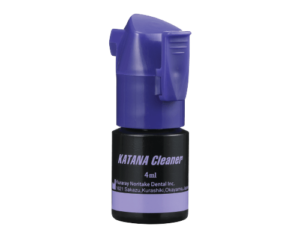With a mild pH and surface-active MDP salt, KATANA Cleaner optimizes bonding by decontaminating tooth and restoration surfaces in just 10 seconds
Blood, saliva, and even glove residue can and will contaminate the intaglio surface of a restoration after try-in. Unfortunately, simply rinsing with water won’t do the trick, as blood and saliva proteins may remain on the surface and compromise bond strength. For Dr. Alfred dela Cruz, KATANA Cleaner removes these contaminants better than any other cleaner he has used before.
“I’ve placed many zirconia onlays and 3/4 crowns, some of which had less-than-ideal retention,” Dr. dela Cruz said. “After using the KATANA Cleaner, those restorations have remained intact.”
 A Better Bond in Seconds
A Better Bond in Seconds
 What makes KATANA Cleaner unique is its mild pH value of 4.5, which allows it to be used both intraorally and extraorally to clean both tooth structure and prosthetics, including glass ceramic, zirconia, resin, metal, fiber posts, and implant abutments.
What makes KATANA Cleaner unique is its mild pH value of 4.5, which allows it to be used both intraorally and extraorally to clean both tooth structure and prosthetics, including glass ceramic, zirconia, resin, metal, fiber posts, and implant abutments.
“Because its pH is lower, I believe it cleans the surface more effectively than higher pH hydroxide-based cleaners,” said Dr. dela Cruz. “I also have much more confidence in bonding zirconia with partial coverage crowns and onlays, which has allowed me to be more conservative in my preparations.”
“For example, instead of opting for a full-coverage crown with little to no remaining enamel, I’m able to confidently bond restorations with less-than-ideal retention form. With the enamel being present, bonding during the final seat is very predictable.”
Before adopting KATANA Cleaner, Dr. dela Cruz would clean his zirconia restorations in an ultrasonic bath of distilled water for 5 minutes after try-in. Using KATANA Cleaner’s one-hand delivery system has eliminated this time-consuming step. “Patients like the shorter time for delivery, but most importantly, they have reported zero postop sensitivity,” he said. With just 10 seconds of rubbing time, KATANA Cleaner thoroughly prepares the tooth and prosthetic for cementation.
Decontaminate with One Drop
Another feature that makes KATANA Cleaner unique is its use of surface-active MDP salt, which weakens the surface tension of the contamination, breaks it up, and floats it to the surface of the tooth or prosthetic.
“After air abrasion, I apply KATANA Cleaner for 10 to 15 seconds, agitating it on the intaglio surfaces the entire time, and then rinse with distilled water and proceed with bonding,” Dr. dela Cruz explained. “Just 1 drop covers the entire intaglio surface, which is great. With other cleaners, I needed to use 2 or 3 drops.” He added that KATANA Cleaner’s bright purple color helps provide a sharper contrast against zirconia during placement and cleanup.
“Since I started using KATANA Cleaner, none of my zirconia restorations, the majority of which are partial coverage, have debonded,” Dr. dela Cruz said. “As long as the evidence shows that the material’s ability to clean and prime the zirconia surface is better than its market counterparts, then I imagine that these restorations will never debond.”